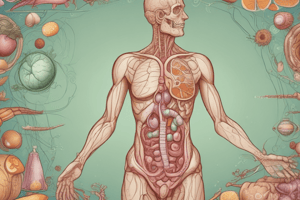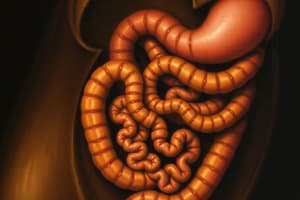Podcast
Questions and Answers
Which of the following best describes the primary function of carbohydrates in a balanced diet?
Which of the following best describes the primary function of carbohydrates in a balanced diet?
- Protecting organs and storing energy for later use.
- Providing the main source of energy. (correct)
- Aiding in tissue repair and immune function.
- Regulating body processes and maintaining immune health.
The large intestine's primary function is to absorb nutrients from digested material.
The large intestine's primary function is to absorb nutrients from digested material.
False (B)
What is the role of villi in the process of absorption within the small intestine?
What is the role of villi in the process of absorption within the small intestine?
increase surface area for absorption
During photosynthesis, light energy is absorbed by ____________, splitting water to release oxygen.
During photosynthesis, light energy is absorbed by ____________, splitting water to release oxygen.
Match the following nutrients with their respective roles in the body:
Match the following nutrients with their respective roles in the body:
Which of the following represents a chemical defense mechanism in the immune system?
Which of the following represents a chemical defense mechanism in the immune system?
Enzymes work optimally at all temperatures with no impact on their efficiency.
Enzymes work optimally at all temperatures with no impact on their efficiency.
Briefly describe the process of phagocytosis.
Briefly describe the process of phagocytosis.
The introduction of an inactive or weakened pathogen into the body to stimulate an immune response is known as ____________.
The introduction of an inactive or weakened pathogen into the body to stimulate an immune response is known as ____________.
Which of the following factors, when increased, would likely increase the rate of photosynthesis, up to a saturation point?
Which of the following factors, when increased, would likely increase the rate of photosynthesis, up to a saturation point?
What is the primary role of carbohydrates in the human body?
What is the primary role of carbohydrates in the human body?
Which of the following is a good source of fats?
Which of the following is a good source of fats?
Which food group is most important for growth and tissue repair?
Which food group is most important for growth and tissue repair?
What is the primary function of phagocytes in the immune system?
What is the primary function of phagocytes in the immune system?
A plant that obtains its nutrition by trapping and consuming insects is showing which type of nutritional adaptation?
A plant that obtains its nutrition by trapping and consuming insects is showing which type of nutritional adaptation?
What type of nutrition involves obtaining nutrients by absorbing decaying matter?
What type of nutrition involves obtaining nutrients by absorbing decaying matter?
The word equation for photosynthesis is: Carbon dioxide + Water + ______ + Chlorophyll → Glucose + Oxygen.
The word equation for photosynthesis is: Carbon dioxide + Water + ______ + Chlorophyll → Glucose + Oxygen.
Which statements describes the role of enzymes in digestion?
Which statements describes the role of enzymes in digestion?
Which enzymes directly contribute to the digestive process?
Which enzymes directly contribute to the digestive process?
The inside of the small intestine is lined with villi that absorb nutrients from the liquid mixture called chyme. What is the pH of chyme when it reaches the small intestine?
The inside of the small intestine is lined with villi that absorb nutrients from the liquid mixture called chyme. What is the pH of chyme when it reaches the small intestine?
Explain the role of villi in nutrient absorption, emphasizing the significance of their structure for this process.
Explain the role of villi in nutrient absorption, emphasizing the significance of their structure for this process.
Compare the dietary needs of a marathon runner and a sedentary individual, considering energy expenditure, protein requirements, and overall health.
Compare the dietary needs of a marathon runner and a sedentary individual, considering energy expenditure, protein requirements, and overall health.
How does herd immunity help contain an outbreak of a contagious disease?
How does herd immunity help contain an outbreak of a contagious disease?
Explain what happens inside the body after a person receives a vaccine, focusing on the role of white blood cells in recognizing and fighting the pathogen.
Explain what happens inside the body after a person receives a vaccine, focusing on the role of white blood cells in recognizing and fighting the pathogen.
The graphs show how different factors affect the rate of photosynthesis. Identify which factor would cause photoinhibition. Explain your answer.
The graphs show how different factors affect the rate of photosynthesis. Identify which factor would cause photoinhibition. Explain your answer.
Explain the role of stomach acid in the digestion of food and how it provides a first line of defense for the individual.
Explain the role of stomach acid in the digestion of food and how it provides a first line of defense for the individual.
If there is too much stomach acid or if the mucus lining becomes too thin, what conditions could this lead to?
If there is too much stomach acid or if the mucus lining becomes too thin, what conditions could this lead to?
Analyze the data described in the data table, and draw conclusions.
Analyze the data described in the data table, and draw conclusions.
If the mechanical barrier formed by the skin is broken, and the malaria pathogen enters the blood, explain the defence mechanism that will come into effect once a pathogen enters the blood.
If the mechanical barrier formed by the skin is broken, and the malaria pathogen enters the blood, explain the defence mechanism that will come into effect once a pathogen enters the blood.
Evaluate the relationship between carbon dioxide concentration and the process of photosynthesis.
Evaluate the relationship between carbon dioxide concentration and the process of photosynthesis.
Flashcards
Role of Carbohydrates
Role of Carbohydrates
Provide the primary source of energy for the body.
Role of Proteins
Role of Proteins
Aid in growth, tissue repair, and immune function.
Role of Fats
Role of Fats
Provide energy, store it for later, and protect organs.
Role of Vitamins
Role of Vitamins
Signup and view all the flashcards
Role of Minerals
Role of Minerals
Signup and view all the flashcards
Function of the Mouth
Function of the Mouth
Signup and view all the flashcards
Function of the Esophagus
Function of the Esophagus
Signup and view all the flashcards
Function of the Stomach
Function of the Stomach
Signup and view all the flashcards
Function of Small Intestine
Function of Small Intestine
Signup and view all the flashcards
Function of Large Intestine
Function of Large Intestine
Signup and view all the flashcards
What are Phagocytes?
What are Phagocytes?
Signup and view all the flashcards
What is Saprophytic nutrition?
What is Saprophytic nutrition?
Signup and view all the flashcards
What are Guard Cells?
What are Guard Cells?
Signup and view all the flashcards
What is Lipase?
What is Lipase?
Signup and view all the flashcards
What is Pepsin?
What is Pepsin?
Signup and view all the flashcards
What are Villi?
What are Villi?
Signup and view all the flashcards
What is Photoinhibition?
What is Photoinhibition?
Signup and view all the flashcards
What is Herd Immunity?
What is Herd Immunity?
Signup and view all the flashcards
What is Chlorophyll?
What is Chlorophyll?
Signup and view all the flashcards
What is Phagocytosis? (Immune)
What is Phagocytosis? (Immune)
Signup and view all the flashcards
What is the Inflammatory Response?
What is the Inflammatory Response?
Signup and view all the flashcards
What are Memory Cells (Immune)?
What are Memory Cells (Immune)?
Signup and view all the flashcards
What is Photosynthesis' role?
What is Photosynthesis' role?
Signup and view all the flashcards
Study Notes
- Integrated Sciences is the subject.
- The exam duration is 2 hours.
- The exam is for Grade 7 (MYP2).
- The assessment focuses on Criterion A: Knowledge and Understanding.
- The paper should not be opened until instructed.
- Reading time of 5 minutes is allocated before the exam.
- All questions are compulsory.
- The maximum achievement level for each criterion is 8.
Criterion A: Knowledge and Understanding
- Students should be able to recall scientific knowledge of the organs of the digestive system and their functions, the immune system, vaccination, and plant nutrition.
- Students should be able to state scientific knowledge of the organs of the digestive system and their functions, the immune system, vaccination, and plant nutrition.
- Students should be able to outline the functions of the organs of the digestive system and their functions, the immune system, vaccination, and plant nutrition.
- Students should be able to describe scientific knowledge of the organs of the digestive system and their functions, the immune system, vaccination, and plant nutrition.
- Students should be able to apply scientific knowledge and understanding to suggest solutions to problems set in familiar situations related to the organs of the digestive system and its functions, the immune system, vaccination, and plant nutrition.
- Students should be able to apply scientific knowledge and understanding to solve problems set in familiar situations related to the organs of the digestive system and its functions, the immune system, vaccination, and plant nutrition.
- Students should be able to apply scientific knowledge and understanding to solve problems set in familiar situations and suggest solutions to problems set in unfamiliar situations related to the organs of the digestive system and its functions, the immune system, vaccination, and plant nutrition.
- Students should be able to make judgments on the importance of the organs of the digestive system and its functions, the immune system, vaccination, and plant nutrition.
- Students should be able to apply information to make scientifically supported judgments on the importance of the organs of the digestive system and its functions, the immune system, vaccination, and plant nutrition.
- Students should be able to interpret information to make scientifically supported judgments on the importance of the organs of the digestive system and its functions, the immune system, vaccination, and plant nutrition.
- Students should be able to analyse information to make scientifically supported judgments on the importance of the organs of the digestive system and its functions, the immune system, vaccination, and plant nutrition.
Carbohydrates
- The primary function of carbohydrates is to provide energy for physical activities.
Fats
- Butter is a source of fats.
Essential Food Groups
- Proteins are essential for growth and tissue repair.
Immune System
- Phagocytes destroy pathogens by engulfing them.
Plant Nutrition
- Insectivorous plants exhibit a heterotrophic type of nutrition.
- Saprophytic nutrition involves obtaining nutrients by absorbing decaying matter.
Photosynthesis
- The word equation for photosynthesis is: Carbon dioxide + Water --(Sunlight/Chlorophyll)--> Glucose + Oxygen.
Life Functions
- Guard cells help in regulating the opening and closing of stomata.
- Enzymes present in our body help in the process of digestion by breaking down complex food molecules into simpler ones.
Digestive Enzymes
- Lipase and pepsin contribute to the process of digestion.
Small Intestine
- The inside of the small intestine is lined with villi that absorb nutrients from the liquid mixture called chyme.
- The pH of chyme in the small intestine is neutral (5.8 to 6.5).
- Villi are small, finger-like projections lining the inner wall of the small intestine, crucial for nutrient absorption.
- Villi structure maximizes absorption through increased surface area (microvilli), thin walls (single layer of epithelial cells), rich blood supply (capillaries and lacteal), and selective absorption (specialized transport proteins).
Marathon Runner vs. Sedentary Dietary Needs
- Marathon runners need a diet rich in carbohydrates (60-70%) for sustained energy.
- Complex carbohydrates help maintain glycogen stores, and proteins are essential for muscle repair and recovery.
- Healthy fats from nuts, seeds, provide long-term energy, and hydration and electrolytes are crucial due to sweating.
- Sedentary individuals need fewer calories with a balanced diet.
- Their diet should include moderate carbs and sufficient fiber for digestion.
- Lean proteins maintain muscle mass, and limited healthy fats prevent weight gain.
- Portion control is key to avoid excessive calorie intake as well as the risk of lifestyle diseases.
- Athletes need more proteins for muscle repair whereas sedentary individuals require fats to limit fat intake.
- Athletes need higher amounts of B vitamins, iron, calcium, and Athletes need higher amounts of B vitamins, iron, calcium, and electrolytes, while sedentary individuals need these in standard amounts.
- Hydration is critical for both, but athletes need significantly more to compensate for sweat loss.
Herd Immunity and Vaccines
- Herd immunity occurs when a large portion of a community becomes immune to a disease via vaccination or previous infection, making it hard for the disease to spread.
- It indirectly protects those who cannot be vaccinated, such as newborns, the elderly, or people with weakened immune systems.
- When a person receives a vaccine, it introduces a harmless part of the pathogen, training the immune system to recognize the real pathogen.
- White blood cells (WBCs), macrophages, detect the invader and send signals to activate other immune cells, forming memory cells.
Photosynthesis Factors
- Photoinhibition is when high intensity of a factor can damage the photosynthetic apparatus of a plant.
- The factor responsible for photoinhibition is typically light intensity.
- The graph shows an initial increase in photosynthesis rate with increasing light intensity, followed by a sharp decline when light becomes too intense.
- At low to moderate light intensities, photosynthesis increases because light provides the energy needed.
- Too much light causes photoinhibition, damaging plant cells and reduces photosynthesis efficiency.
Stomach Details
- Stomach acid (hydrochloric acid) plays a vital role in digestion.
- The stomach creates a highly acidic environment that breaks down food and serves as a defense mechanism.
- The acid denatures proteins making it easier for the enzyme pepsin to digest them into smaller peptides.
- The hydrochloric acid kills or inhibits harmful bacteria and pathogens ingested with food.
- The stomach's inner lining is coated with a thick mucus layer that protects it from acid damage.
- Too much stomach acid or a thin mucus lining causes acid to damage the stomach lining and esophagus.
- Excess acid can lead to acid reflux, where acid flows back into the esophagus, causing heartburn.
- A thin mucus lining allows stomach acid to erode the stomach lining, leading to gastric ulcers.
Photosynthesis Factors Graph
- Light intensity (x-axis) and the rate of photosynthesis (y-axis) are shown at 25°C and 30°C with a constant CO2 concentration (0.04 ppm).
- The graph compares rates at 25°C and 30°C for the rate of photosynthesis initially rising as light intensity increases.
- Initially, light intensity is the limiting factor until the point when temperature or CO2 concentration becomes a factor limiting the enzyme.
- Once the curve levels off, light is no longer limiting, and temperature or CO2 concentration become limiting factors.
- At 30°C, the rate of photosynthesis is higher compared to 25°C at the same light intensity, and light intensity controls the initial rate until the plateau is reached.
Proving Photosynthesis and Oxygen Production
- During photosynthesis, light energy is absorbed by chlorophyll in plant cells and converted into chemical energy to convert carbon dioxide (CO2) and water (H₂O) into glucose (C6H12O6) and oxygen (O2).
- Without light, plants cannot perform the light-dependent reactions needed for photosynthesis.
- The oxygen (O2) released during photosynthesis is vital for almost all living organisms supporting cellular respiration and ecosystem balance.
- An aquatic plant (like Elodea) is used for its visible oxygen production because aquatic plants release oxygen bubbles directly into water, simplifying data collection.
- Terrestrial plants release oxygen into the air instead, which harder to measure.
Malaria Deaths
- Malaria deaths went from 159 deaths in 2005, to 92 deaths by 2015, with the sharpest decline between 2005 and 2011.
- This data suggests malaria control measures, such as better preventive strategies (e.g., insecticide-treated nets, anti-malarial drugs, improved healthcare), have successfully reduced malaria death rates.
- Once the mechanical barrier (skin) is breached and the malaria pathogen (Plasmodium) enters the bloodstream, the body's immune system activates several defense mechanisms.
- Phagocytosis, inflammatory response, and memory cell formation are all defense mechanisms that come into effect once a pathogen enters the blood.
- Memory cells remain after infection to provide quicker and stronger responses if the pathogen re-enters in the future.
Variegated Leaf Experiment
- Starch formation (photosynthesis) only occurs in areas with chlorophyll (green parts).
- Areas lacking chlorophyll cannot produce starch as they cannot photosynthesize.
- Photosynthesis requires light, carbon dioxide and water which results in oxygen production.
- Photosynthesis requires light energy to convert carbon dioxide and water into glucose, which is then stored as starch.
- The plant cannot photosynthesize due to the darkness and there will be detection of starch in either the green or white areas after testing with iodine solution.
Carbon Dioxide Concentration
- During the night, plants stop photosynthesizing but will continue to respire which releases carbon dioxide into the surrounding air.
- Sleeping under a tree at night may not be advisable because it will expose a person to higher concentrations of CO2, which reduces oxygen availabilty.
- The graph shows a relationship between CO2 concentration and photosynthesis.
- As photosynthesis increases during daylight, CO2 levels drop because plants are absorbing CO2 for glucose production.
- This cycle highlights the crucial role of photosynthesis in regulating atmospheric CO2 and maintaining the oxygen-carbon dioxide balance.
Studying That Suits You
Use AI to generate personalized quizzes and flashcards to suit your learning preferences.




